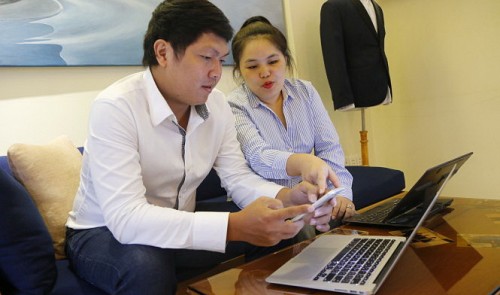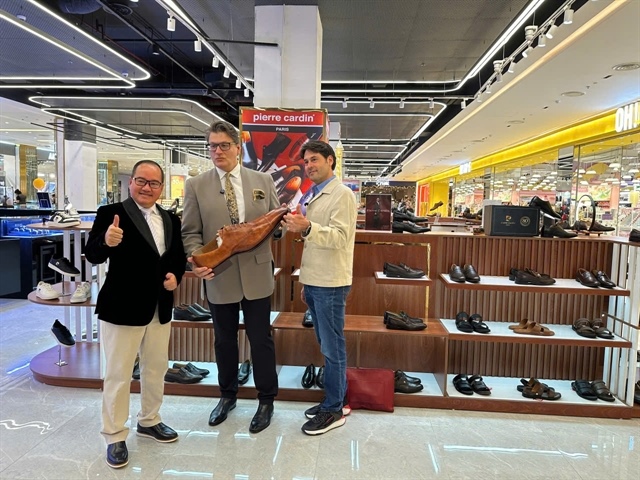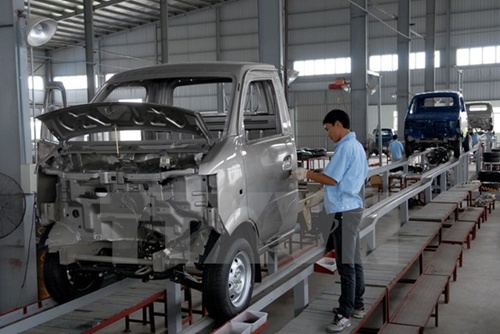‘Digitized’ tailoring booms in Vietnam
‘Digitized’ tailoring booms in Vietnam
An entrepreneurial couple in Ho Chi Minh City have created a smartphone application capable of creating custom shirts, while online tailoring services continue to gain a foothold.

“I don’t know what’s wrong with this suit, but I certainly can’t wear it,” the foreign boss of Tran Dam Minh Phuong, 33, complains about the outfit he has just paid for.
The tailor’s, which Phuong introduced to her boss, has been popular among fashion enthusiasts in Ho Chi Minh City.
After years working with foreigners, Phuong realized the importance of a good quality suit to foreign company executives, with a good one helping to accentuate their confidence and personality.
Many of these entrepreneurs are also particular about the details, including how to do up buttons, take off their suit jacket, place it on the chair’s arm and even loosen the tie knot, Phuong observed.
She realized after an embarrassing situation that arose with her boss that the fine line between first-rate custom-made clothing and its off-the-rack counterparts lies in the sense of confidence and comfort that they give the owners.
It was then that Phuong and her husband decided to open a small shop specializing in Western-style suits, ensuring they satisfied even the most fastidious customers.
A perfectly fitted garment needs exact measurements, which can only be taken by professional tailors.
This poses a considerable problem as few people can now afford the time to go to the tailor’s.
By accident
Phuong and her 34-year-old husband, Nguyen Ngoc Lam, visit those clients in close proximity to their homes to take measurements, but have had their hands tied with those residing in suburban districts, other provinces or countries.
Phuong later came across an online measurement-taking application on the Internet, introduced by an American man.
The man claimed that the application could take measurements in less than 30 seconds, adding that it guaranteed more precise measurements than conventional methods.
It dawned on Lam that the application adopted math and spatial geometry formulae.
After days groping for the algorithm and programming, he finally came up with the formulae.
Delving further, he discovered that the app developer had hired nearly 1,000 people with a wide array of physiques, builds, measurements and weights to create a database of measurements both with the device and manually in order to compare and perfect the differences.
The metrics were then subcategorized, each with a different formula, as people with the same height and weight may have different builds.
Over one year later, Lam’s online measurement app was finalized and launched onto the market under the name UKYS.
“It was then tested on thousands of body types to design the optimal algorithm. We believe that UKYS is a new approach to tailoring that enables skillful tailors to supply a service to people they have never met,” Phuong said about her startup project.
Using clients’ photos taken as per the app's instructions, UKYS converts the data into a comprehensive body metric as would a seasoned tailor.
Choices about fabric and shirt details are then made available to users who are also able to customize things like collars and cuffs. Upon receipt of all of the measurement data and the user's style preferences, the production team, comprising a 15-year-old family tailoring business in the UK, will then tailor the shirts according to the information captured by the app.The app is presently only compatible with iOS devices. The application first attracted attention on crowd-funding website Indiegogo (US).
In August 2016, Lam and Phuong claimed first prize at “The Ambassador’s Entrepreneurship Challenge” with their smartphone app for iPhone/iPad users.
The competition, organized by the U.S. Embassy in Vietnam, was designed to spur young local entrepreneurs to launch a startup project and help create a healthy startup ecosystem.
The couple’s app has also drawn big names in the textile industry including Albini and Dormeuil, who have sent staff to Phuong’s showroom in a small alley to introduce their products.
“We didn’t think our app would get this much attention. Our foreign partners said they could visualize a new future for the garment industry based on our approach,” Phuong said.
Phuong and Lam are highly dedicated to their job.
A Japanese man once came to see the couple, admitting to them that he had been expelled by a famous tailor because of his relentless insistence that his suit be readjusted several times.
He wondered whether Phuong and her husband could satisfy his very specific preferences.
Phuong said that she and her husband would buy imported suits costing dozens of millions of dong each (VND1 million is equivalent to US$44) and take them apart for their inner workings.
A number of Vietnamese seamstresses have said they are no stranger to technically demanding foreign techniques, but are reluctant to adopt them as the time-consuming method raises the price, and in any case, most customers cannot really tell the differences.
Phuong ensures that all of her clients go home satisfied with their outfits, no matter how many readjustments she and her husband have to make.
Online tailoring services boom
Minh Tam, a designer in Ho Chi Minh City, who ran a tailoring shop in District 3 four years ago, is now doing good business from her rented apartment in Phu Nhuan District.
On her tastefully designed “Tam Fashion” Facebook account, Tam showcases an assortment of her designed dresses and provides them with counseling and handy instructions on how to collect their measurements and pick the right styles and fabrics.
“I can make a nicely fitted garment, including evening gowns, wedding gowns and ao dai [the traditional Vietnamese long gown] just by asking my clients to give me a photo of themselves, their body dimensions, height and weight and some special physical features,” Tam said.
Her clientele range from locals to foreigners and Vietnamese expats.
With today’s Internet boom, even modest tailoring shops located in small alleys have begun digitizing their services.
These shops typically demand a deposit of 50 percent of the garment’s value in advance.
The garment will be returned to the tailor’s and readjusted several times if it does not fit or look good on the wearer.




















